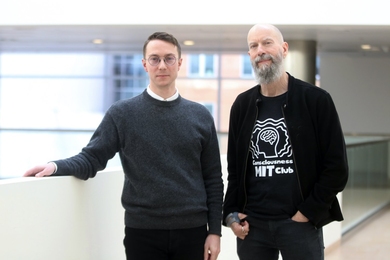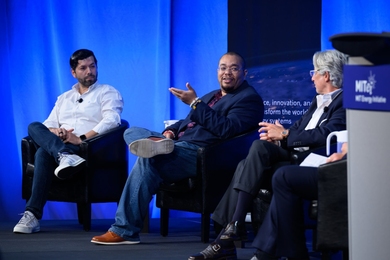CAMBRIDGE, MA--The road to instantaneous worldwide communication is being paved but still requires a bit of airplane travel. The link between Shanghai's Number 2 Secondary School and the rest of the world has just been forged by two MIT students who traveled to China last summer to set up the country's first high school Web server.
The Master of Engineering in Electrical Engineering students, Ron Cao and Jake Seid traveled to Shanghai to teach the students from the Number 2 Secondary School attached to East China Normal University about e-mail and the Internet, to train them how to make home pages using HTML, and show them how to set up and maintain a Web server.
Their project, the "Computer Educational Development Initiative in Shanghai China" had three goals:1) to enable the students to use their technical understanding to advance computer-aided education in China,2) to build multi-cultural understanding and awareness between younger generation Chinese and Americans,3) to create an opportunity for MIT undergraduates to form a lasting relationship with students and teachers at a Chinese high school.
"Not only will e-mail facilitate communication between East and West, but, as other Chinese high schools follow the model set by the Number 2 School, e-mail will facilitate communication among the younger generation of China's many provinces," said Cao.
Cao and Seid helped the school to set up e-mail accounts for both students and teachers to enable communication between MIT and the high school.
At the end of five weeks, the high school students had created China's first student home pages, China's first Internet educational program (where students can do math, physics, and chemistry problems on the Web in Chinese), and China's first on-line Chinese HTML primer.
"This is one of the most exciting projects we've started," said Prof. Suzanne Berger, head of the MIT International Science and Technology Initiative (MISTI), which along with the Eloranta Fellowship funded the student project.
"One of the most striking lessons I learned was the importance of being able to see issues from a non-American point of view," explained Seid. In order to understand the needs and concerns of another culture, you can't assume that the "American way" of doing things will always be correct. This experience will make me more sensitive to differences in perspectives that exist across cultures."
Seid is currently studying the future of the information technology industry as part of MIT's Made By Hong Kong project.
Cao and Seid proposed a continuation of their project, the MIT-China Educational Technology Initiative (MIT-CETI), to MISTI. Under this initiative, two MIT students would go to Shanghai next summer to help the Number 2 Secondary School further advance its computer-aided education program--possibly setting up a local area network, teaching C or Java, or expanding on the HTML work done this year.
MISTI, through monies from the Dr. Ge Y. Chu Fund and the Freeman Foundation Grant, has just announced that it will fund a second year of the program. Their program is currently seeking two more MIT students who are interested in going.
"These are opportunities for our students to establish partnerships with Chinese students and researchers that we hope will continue for their whole lives," said Berger.
China is an emerging center for innovation and industry, said Berger. "With this program there are long term mutual benefits for China and the US--many American firms are extremely interested in not only selling to China, but being close to the innovation there."
Cao and Seid felt that working in China allowed them to understand the Chinese people and culture at a much deeper level than they could have otherwise. Through MIT-CETI, they want more MIT students to be able to gain the same invaluable experience.
"Being a student at MIT, it's easy to get caught up in technology for technology's sake and not see its greater role in society," said Seid. "For MIT students, affecting society with technology means taking a global perspective, and hopefully, our new program will help give students that understanding."
The high school Web site URL is http://202.120.80.2>. According to Cao, there is only one 128k line connecting the Internet in America and China, so it is sometimes very difficult to reach the main site. You can see the mirror site by linking off the MIT-CETI home page http://web.mit.edu/people/jjseid/mitceti.htm>.





